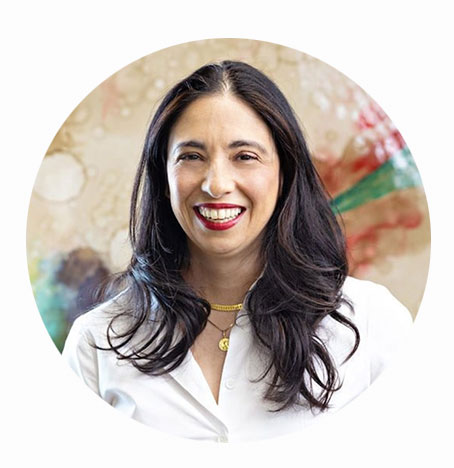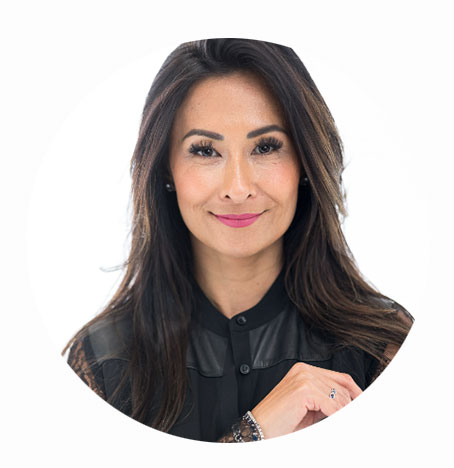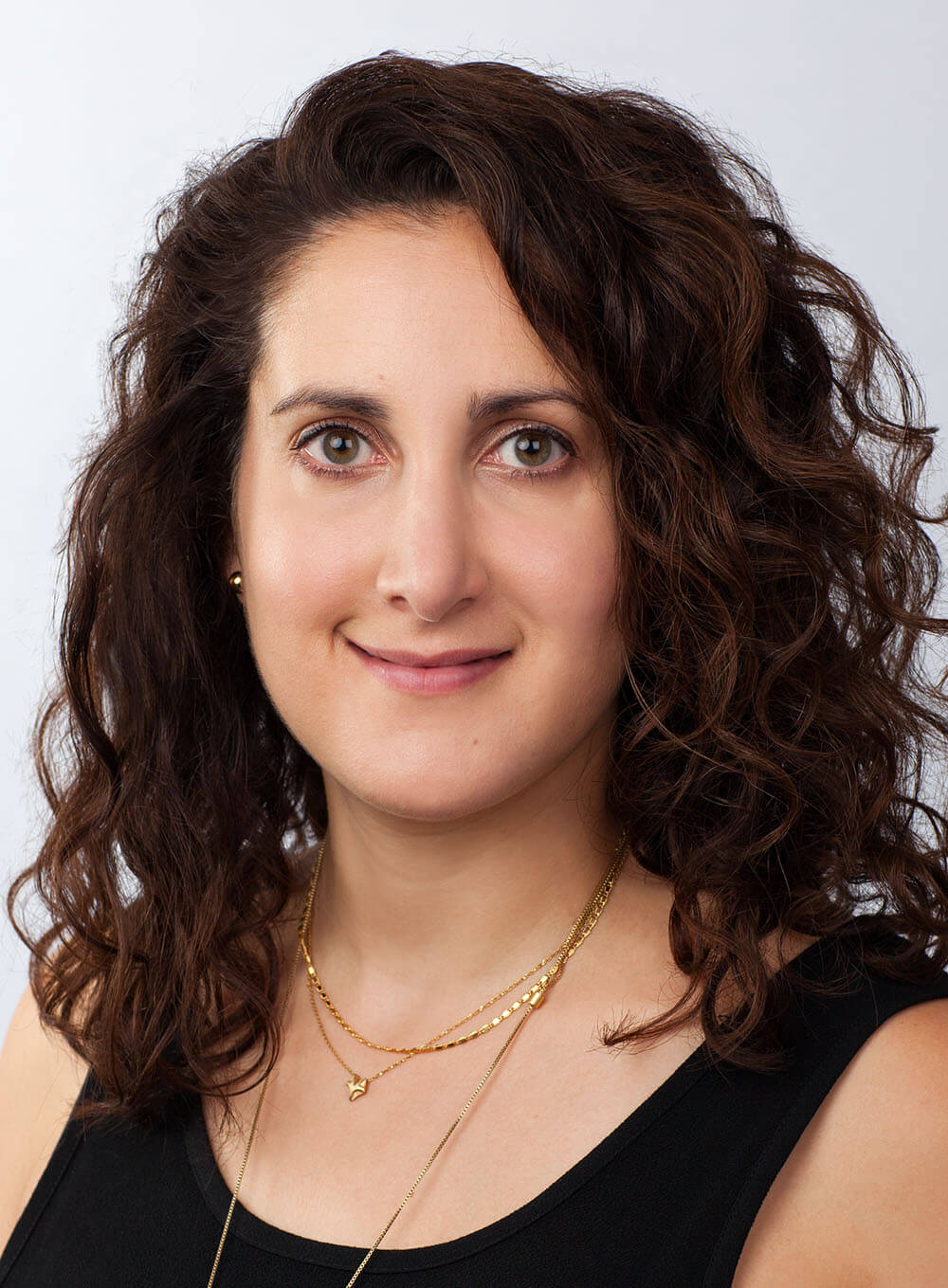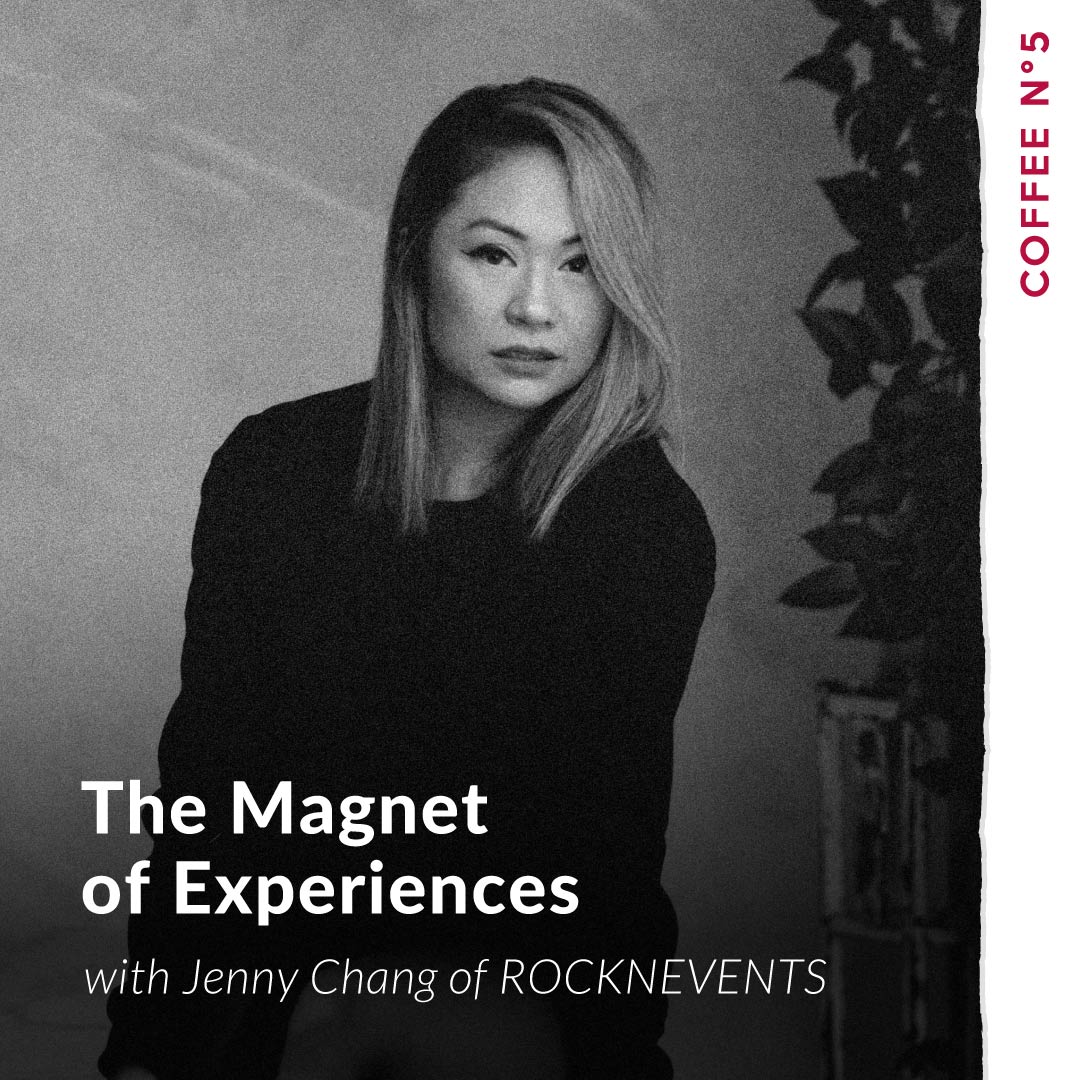Lara Schmoisman
00:05
This is Coffee Number Five. I’m your host, Lara Schmoisman. Hi, everyone. Welcome back to Coffee Number Five. It’s so hard to develop products. I help a lot of clients to go through this. I mean, not from the beginning, but I know how hard it is to get packaging and to get design done and get the branding done that connects with your products and the ingredients. And how difficult is that? But many times brands come to me when they’re ready with the products. They go through the manufacturer process, and that’s a long process, and you don’t know what it takes. So today we invited Andrea Cid. Welcome, Andrea. I’m so excited that you’re here today.
I know Andrea for a long time, and I know how fantastic her and her team are in helping also small brands to start from scratch and to start from the beginning when they only have a concept or an idea.
Andrea Cid
01:10
Thank you so much for having me, Lara.
Lara Schmoisman
01:12
So, Andrea, you are the founder of Miami Growth Machine, but you grew up in a family business also. So even in this industry for a long time. So why you don’t tell us a little more about how you started Miami grown machine and why you feel like there was a need for another manufacturer in this space?
Andrea Cid
01:36
Sure. Thank you. Yeah. So I started Miami Growth Machine in 2020, towards the end of 2020, when were trying to figure out what to do with all of these different clients that were coming to us, that were smaller, looking to launch new products and who were looking to do really innovative, interesting things, but the manufacturing process. So I have a manufacturing facility here in Miami, in Doral. It’s 40,000. We manufacture our own bath and body products. We had been doing that for the last eight years. But we always do private label. And new clients coming in and asking us for private label the traditional way wasn’t really working for them. It wouldn’t have been the way that we would have wanted to launch new products either. Most of the time, manufacturers will require you to have very large minimums.
Andrea Cid
02:33
They’ll want you to have your formula already set or to take a stock formula off the shelf. There’s not a lot of customization.
Lara Schmoisman
02:39
Sorry, Andrea, I want to interrupt you for a minute, because I want to explain the difference of a private label that many times is a white labeling solution.
Andrea Cid
02:49
Yes.
Lara Schmoisman
02:50
So I would love for you to explain that a little more. And what’s the difference?
Andrea Cid
02:55
Well, we have clients that are very large, and they might say, for example, have a retail presence or they have their own retail stores and they sell a bunch of different products, but they’re looking to have their own brand on a particular type of product. They want to add to their product mix that way, but their own brand is not the key thing that they’re selling. They’re a retailer. So we will manufacture for them a white label product. We’ll put their brand on packaging that they’ve selected, but it’ll be a stock formula that we already have that’s stable, that we’ve tested. We might do slight tweaks to it, but it’s very much something that’s just off the shelf. It’s not something that’s custom.
Lara Schmoisman
03:47
Okay, but that’s where Miami Growth Machine came in and made the difference.
Andrea Cid
03:52
Yes. So we do formulation, we do supply chain management and manufacturing with no minimums. And that was really the key to understanding how to work with startups for ourselves. We would never launch a product with 30,000 units and see how it goes. When we launch a new product for our own, our concept two brand, we usually do about a pilot batch of about 1000. We test it with customers, but we’ve already done the back end work with supply chain, with the formulation, so that when we get purchase orders, then we can do larger batches and ship out, but only when we know that there’s demand and we don’t have to tweak.
Andrea Cid
04:33
You know very well, when you launch a new product, you’re constantly having to maybe make little iterations or slight changes as you get it into people’s hands and you see what it’s actually like to try to sell it.
Lara Schmoisman
04:46
Yeah, you get a lot of feedback from your initial batch. I mean, each product has a shop life also. And I see that a lot of brands that they’re starting out, they need to do these huge moqs and they’re with products which, it’s not very sustainable either. We talk a lot about sustainability in many other ways, but wasting product and ingredients is not very sustainable.
Andrea Cid
05:15
No, it’s a great way to end up with a lot of landfill or to have your product end up discounted severely at a discount store like a Marshalls or a TJ Maxx, because you might have to make a small change or an ingredient might not work anymore for a particular retailer, or a change just needs to happen. And that is, I think, very common for a new product launch. And that’s the issue with the traditional way of manufacturing. Manufacturing wants scale. Manufacturing wants you to have everything smooth so that we just go in, we turn a machine once, and then you pump out a ton of product and then you’re done. But that isn’t really meshing with startup and it doesn’t mesh with the way that a brand needs to work.
Andrea Cid
06:04
So because we have that brand experience, we know what that’s like to do that for ourselves. Sometimes we have orders and we only need 15 cases of a particular fragrance to finish a container load. We’re not going to do a huge batch just to fill that order. We’re going to try to get the order out as quickly as possible. So we’ve developed ways to do smaller and bigger batches, smaller, medium, larger batches, so that we can get orders out ourselves. And I figured, why are we trying to fit startups into this large manufacturing model that doesn’t work for them, instead of actually catering to them, creating a menu of services that makes more sense for them, and actually helping them get orders out and get product into the hands of clients so that they can then get that feedback in real time.
Andrea Cid
06:57
The other thing is the cash flow issue. When you’re first starting out, cash is. Cash is always important, but it is so critical for you to have budget for marketing, for promotion, for all sorts of other things. If you’re having to spend 10,000, 30,000 unit order just on getting one sku out, how does that actually allow people to enter this market unless they have a legacy brand, unless they already have a huge distribution network? It makes it very difficult for new entrants to innovate, and I think that’s where it’s interesting.
Lara Schmoisman
07:45
That’s really well said, because I see that with a lot of brands getting to us that they have no marketing budget. And when you have no marketing budget, it’s really hard and you might need to end up in discount stores. And for a new brand, when you get in a discount store, it’s like you’re already a discount store brand and that’s something that you don’t want to at the beginning of your journey.
Andrea Cid
08:08
Well, yeah, it means you can’t get a return back and you’re learning the hard way. So we’ve gone through a lot of those issues ourselves. We’ve seen that with clients. So we hope to preempt some of those problems for our clients by first of all helping them do smaller batches at the very outset, but also connecting them with vendors that are understanding of where they are and allowing us to just get product out in a quicker way without having to take out so much cash just on the production side.
Lara Schmoisman
08:48
Well, so let me ask you a question. So someone comes to you with an idea, a concept, somebody that, because I’ve seen it a lot lately, that there is a lot of people that they want to own a brand, beauty brand, because either they believe that the margins are great, which are not at the beginning, and this is something that we need to discuss too. They might not because you’re going to have to invest a lot into marketing, a lot of giveaways into create brand awareness. So all the money is going to come from your product that at the beginning you might not have a huge return. So that’s something you need to be prepared. But how do we start? Okay, what is your recommendation?
Andrea Cid
09:32
How do someone, the very first thing I tell clients that, because I have conversations with founders all the time, and the first thing that I really want to understand is do you have a brand? Have you already developed a brand deck? Do you have a real clear understanding of who your client, you just said.
Lara Schmoisman
09:55
One of my favorite words, brand deck. Yes.
Andrea Cid
09:58
So I want to see that, because that’s a concrete way of showing me that you’ve done all of that homework. Because in order to produce that, you really have to have conversations with someone that’s going to help articulate in a physical sense the concepts that you have in your head. A lot of times I speak to clients that are, they’re focused on the product. They want a serum, they want a perfume, they want a particular whatever reduction, some cream or whatever it is that a hair product. But it’s not about the product. Your product needs to be brand reinforcing and you can’t have a brand reinforcing product. There are so many dozens of decisions that need to, tiny little decisions that you need to make to get to a product.
Andrea Cid
10:51
The cap, the bottle, the packaging, what ingredients are you going to highlight, what claims are you going to try to highlight? Or are you going to be able to say, what are you trying to achieve with it? All of that has to be brand reinforcing. And so if you don’t have a clear target for that, then it’s just a never ending circle of options that will never really kind of fit what you’re trying to do. But then you’re just trying to see.
Lara Schmoisman
11:19
What you need to know who you are and who you’re not. That’s really important for me as a brand. And also I always encourage founders to go and walk the stores when they will love to have their brand and which are their competitions, in what shelf they want to have it. Because also that depends a lot of the price point that you can go for when we start talking about ingredients, then when you start talking about the packaging and how do you design the packaging? It has to attract that target audience. But at the same time, how can you stand out in that shelf?
Andrea Cid
11:57
Exactly. So you can’t make any of those decisions if you don’t first have a very clear view of who you are. Once you do have that, then all of that really starts to fall into place. Because now you’re saying, okay, we’re going to use these ingredients, but not these ingredients. We’re going to look at these type of packaging and not this other type of packaging. And so that then helps clear the field a little bit, because there’s a lot of choice and a lot of decisions that need to be made when you’re trying to put an actual physical product out into the world.
Lara Schmoisman
12:26
Absolutely. So that’s the first step. Next step. What’s the next step?
Andrea Cid
12:31
The next step is we have. So if we’re starting from scratch, from the formulation standpoint, then we’re looking at doing a kickoff with clients where we talk about their brand and then we talk about what they’re. If they have a product development brief all ready put together, that’s awesome. If they don’t, then we help create that together so that we have answers to all of the key questions that we want with the formulation, including the cost. The way that we work, I think, is quite different because we’re an extension of our clients team. So we’re not going to just give you a formula that we’ve already used and that’s worked for other people because we want it to be, again, brand reinforcing. So that involves cost. And I know we’ve seen, both you and I have seen clients where they love their formula.
Andrea Cid
13:27
It’s phenomenal. But their formulator has put in so many incredibly expensive ingredients into it, or they’ve painted themselves into a corner with different supply chain issues that now they have to either price it extremely high or it’s not going to work for their margins. In that case, then we would reformulate, and there are definitely ways. So we formulate from the very beginning with price in mind.
Lara Schmoisman
13:57
That’s super important to know what ingredients you’re going to use for the pricing. I want to tell a little story about someone that I think even Andrea sent these people to you. So you’re going to know the story that I talked to someone who, and I think this is where also Miami Growth Machine really stand out, that you guys give the formula to the client immediately.
Andrea Cid
14:19
Yes. Our formulas are owned by our clients. And that is, I think I feel very strongly about that because I want clients to really understand what’s going into their products and to have an understanding of the supply chain behind that. But if you’re looking to, my goal is to have these companies grow and thrive and create an ecosystem of CPG innovative companies coming out of Miami. That’s what I want to do. So for me, it’s not about me holding on to these formulas. I’m not going to commercialize them. I’m not looking to launch 15 brands myself. That’s not what I’m trying to do. I want to see you grow and thrive.
Lara Schmoisman
15:04
That’s why we get along great because we have the same philosophy, help our clients. But I’ve seen a lot of people that I have, these people coming to me, that they have one product, one skill, that it wasn’t formulated to budget. So it was crazy. The amount of money that they will have to sell it for, and it will never get the return of. There was no margins. They could not ever go retail because there was no margin. And on top of that, they didn’t own the formula, so they would have.
Andrea Cid
15:36
To reformulate anyway in order to own it. And that could be fine if you’re.
Lara Schmoisman
15:42
A private label client and they invested hundreds of thousands of dollars in having that formula.
Andrea Cid
15:49
That’s the part that really burns me, because it’s not necessary to do that. You can recreate a lot of things in very practical, effective ways. Again, it’s about your brand. I manufacture for mass market brands and for luxury brands. It’s not about like, oh, this isn’t good or this is good. It’s about what works for your target market and your client. And price is a big component of that. If you’re not going to have a product that your clients are going to be able to that’s accessible to them, then what’s the point of putting something out that the idea is not to be manufacturing artisanally with like, tiny batches forever. The idea is to get stuff out in a very practical, effective way so that then you can scale up and you can reach all of your people.
Lara Schmoisman
16:44
Okay, let’s talk about packaging. Because packaging, I found that there’s a very sticky situation there. It’s the hardest part of any brand because not only the minimums of packaging many times, but also to create. When you’re creating a line of products, a collection of products, you want it to be branded, cohesive, but at the same time, not every product can be used in the same containers. So you need to make decisions. Bottles, pump, no pump tubes, metal tubes, plastic tubes. You want to be sustainable, but at the same time those emulators are higher. It’s crazy. So what’s the law here? How do we.
Andrea Cid
17:33
I think the best thing to remember is that you have three main categories of how you kind of are thinking about packaging. You have speed, you have cost, you have customization, and unless it’s a very special situation, you have to pick two if you’re looking to go to market quickly, and then you’re going to want to have stuff here that’s already in the US.
Lara Schmoisman
17:57
So then the cost is going to go higher.
Andrea Cid
18:00
The cost is going to be a bit higher and indefinitely per unit, but it’ll allow you to get stuff out quickly. There are vendors that we have that we can order a few case packs of and it’ll be here, but they’re.
Lara Schmoisman
18:12
Not going to be custom either.
Andrea Cid
18:13
They’re not going to be custom. So then you don’t have price, you have speed, and you don’t have customization because you’re going to have a limited selection. I always tell clients, you can have anything you want. You really can. We can make absolutely anything you want if you have the budget for it and if you have the time, because then we can customize things with different vendors that we have around the world and you’ll get. Exactly. You can have a mold if you want it, if you want your own custom mold. All of this costs some money and it takes time because we need approvals and testing. And then part of what we do when we finish our formulation work and as we’re doing our formulation work is we’re also doing compatibility testing with packaging, because that is important.
Andrea Cid
18:59
But it’s kind of like these two streams that are coming at you.
Lara Schmoisman
19:03
Yeah. And that’s really important that you need to know. First of all, you’re going to do your testing for the formula, but then when you finalize choosing a packaging, you need to do testing, too.
Andrea Cid
19:13
Yes. We want to make sure it’s not going to clog in the pump. There’s just a variety of different things that can go wrong, especially when you’re launching something new. You don’t know what.
Lara Schmoisman
19:23
No. And there are some ingredients, for example, they cannot be in the clear bottle or another ingredients that are also, like, were having this discussion, the size of a pump, how much product you want. I didn’t know that one. That how much product you wanted to come out of the pump?
Andrea Cid
19:42
Yes. So depending on the type of product.
Lara Schmoisman
19:45
Because you need to think that when you put a product out there, people are going to be reviewing you constantly. So it could be about the user experience. If too much product comes out or too little, or if you’re wasting product, those things can come back to you. So you need to be very thoughtful of every part of the process.
Andrea Cid
20:06
I think it’s important to go through all of those steps and to not skip any steps. But at some point it is also important to just get stuff out into people’s hands. Because while, yes, you can always reiterate and improve. And I do think that it is good for founders to have this concept of you’re getting something out there right now. This is what you’re producing out in the world. But it doesn’t mean that when you get to the next level and as you’re growing and you’re able to do more customization, because you’re going to have the orders to support larger moqs, then you get more options, your margins go up because you’re able to decrease costs as you scale. All of those things will make it a little bit easier.
Andrea Cid
21:02
But it doesn’t necessarily have to be perfect on the first shot. It needs to be good enough to get it into people’s hands so that you can test it. And, and yeah, of course you don’t want something to not be stable. You don’t want something to have, like a significant mistake. But I’ve seen large brands. I mean, if you do go to Marshall’s, this is one of my favorite things to do. I get great products, they’re great. But, yeah, the pumps don’t work. Something’s wrong with it. An ingredient didn’t work quite right. The reason they’re there is because someone made a mistake on the amount of inventory that they purchased. Every single one of those products is an inventory mistake in some way.
Andrea Cid
21:51
So don’t feel too bad about your own brand, because these are really large companies with huge budgets and huge teams that are taking years to produce products, and they make mistakes. So it’s not really about that. I think it’s more about getting as close to your ideal and remember continuing.
Lara Schmoisman
22:14
To improve something else. I always say, do your market research, because first of all, I see a lot of people with great ideas. But I always ask, have you looked if there is something exactly the same? Because you don’t want to be one more, you want to be different somehow. And that’s where you need to talk to Andrea or to whoever is manufacturing for you say, hey, what ingredients can we use to be different to see what’s in the market, but you’re not exactly the same, or you have a.
Andrea Cid
22:48
Twist on exactly whatever it is that’s already out there. I really like working with products where it’s something that is already kind of out there, but they’re going to do it in a slightly different way or they’re going to target a slightly different consumer. And I think that’s very clever because these are products that are tested. They’re out there. They’re not completely like, no one’s ever done this before, but you have the ability to put your own mark on it. Oftentimes. It really is also about, we go back to the same thing over and over again, but it really is about your brand. Who are you communicating to? Who is this product speaking to? All of that is, that needs to.
Lara Schmoisman
23:40
Come from your deck too, from the brand voice. And I feel like a lot of people do a deck and say, oh, this is my brand. They have a beautiful logo. But then there is not that voice of the brand. And as your brand evolves, many times you’re going to find out that your target audience is not necessarily who you thought it was sometimes. So you have to tweak that voice or you’re going to find that your target audience is who you thought, but you can narrow it more and get more.
Andrea Cid
24:10
So I’ll give you an example for my own brand. I just came back from Dominican Republic, where were looking at speaking to our distributor there, and we looked at the numbers for last year, for the last year and the current production for the amount of sales that they’ve done this year. I wasn’t totally shocked because I kind of knew this about the Dr. But our men’s products are selling three times as much as our women’s products. And so we started digging into why that is, because that’s definitely not the case in the US. It’s not the case in some other parts of the world that where we sell. And we realized, one, the amount, the competition, there’s not a lot of competition on the shelves for the men’s products.
Andrea Cid
25:01
And our fragrances hit spot on the market that dominican men are really interested in. And so we’ve hit the mark on fragrance, on price, on where we’re distributed, and it’s been a huge boom. So now I know we can go deeper into that category.
Lara Schmoisman
25:23
So what I will say is that.
Andrea Cid
25:24
You do, but I wouldn’t have known that. I wouldn’t have that. I wouldn’t have known that until were out there in the market with sales actually having some data.
Lara Schmoisman
25:35
Yeah, well, data is so important. And so when you analyze it, then you can tweak things. And I know that now, for example, you can do more, I don’t know if you do it or not, but if you do more ads and you can do a different ad in. Dr. Yeah. You can do an ad more targeted to men in certain price point.
Andrea Cid
25:59
Exactly. So that’s part of the information that we get. We always knew it would be popular, but we didn’t realize that it would be even more successful than the women’s fragrances because there’s more competition on the women’s side.
Lara Schmoisman
26:15
Well, yeah, geolocation is as important. I’ve seen it with a lot of brands that maybe they expected in big cities to be successful. And we found out that actually in the suburban, they work better because they don’t have access to go to the big stores, but they still want to have this experience or experience this product. So we found out that we didn’t have to put so much advertising because people will see it on the shelves, but we need to get into other people’s households.
Andrea Cid
26:51
Right.
Lara Schmoisman
26:52
So you really need to analyze where your market is. So, Andrea, so how long is from the average, from when you start with the concept until you can be in market?
Andrea Cid
27:04
That’s going to really depend on the type of product and again, on the packaging that you’re choosing. If you’re looking for something custom, you’re going to spend at least six months in development, and then it’s going to be potentially three to four months before you get something shipped. So if you’re looking for something rather faster than that, then you’re probably going to look at packaging that’s already here in the US and at least make that a simple. Yeah.
Lara Schmoisman
27:35
Do you work in developing the formula and packaging at the same time, or they need to be.
Andrea Cid
27:41
One thing follows the no, I like to work at the same time, but it also will depend on the client. So the way that we work is we kind of fit in and fill in the gaps where our client may not have additional support. So if they don’t have a formulator, we have our lab and our team here that formulates. If they don’t have packaging experts, then we work with that. But sometimes we have clients that already have that. They already have designers and packaging. They’re looking to launch a new product, and so they’re sending us their packaging, and we’re testing at the same time we’re testing the formula. And then obviously then if they’re sending me the packaging and they’re like, okay, we have this pump, this is what we want, this is what were thinking of.
Andrea Cid
28:23
Can you formulate and test it in this? Then that makes it a lot faster. So then we’re only ordering ingredients, going through stability, testing it, sampling it, getting approval.
Lara Schmoisman
28:39
So what are the basic things that you see that people come to you or new brands come to you that they should have known? That they don’t know?
Andrea Cid
28:54
I wouldn’t say that they should have known. I don’t expect anyone to really know how to do this unless you’ve already done it. This isn’t like something that you get taught or that is necessarily obvious at all.
Lara Schmoisman
29:06
You cannot go to school for this. No.
Andrea Cid
29:08
I kind of wish I had taken my opt in classes more seriously when I was in grad school, but I vaguely remember one class that we took. It is a learning by doing kind of situation. So I wouldn’t expect. What I really like is when customers really understand their target market, their brand, and their job is sales and marketing. In my view, our job is operations. So you’re outsourcing that part to us. But at the same time it’s a collaboration of both, right? Because you can’t do one without the other. We’re making it together, we’re trying to make that happen. So I don’t expect clients to know things that I didn’t know when I started and that I’ve been doing this, now for twelve years and I’m still learning stuff.
Lara Schmoisman
30:05
There are certain things, like you just said, you need to have your brand deck and you need to know who your brand is. Start working on your trademark.
Andrea Cid
30:14
I really like your suggestion. I always say the same thing, go to stores. But now when you go to stores and I show people packaging, look at the packaging, you’re going to realize that you’re going to see the same bottle over and over again. There’s a reason for that. There’s supply chain behind that. So there’s a reason that you see Boston rounds and bullets and that’s what’s available, that’s what’s getting manufactured. Millions of them are out in the market. People are putting different labels and printing them in different ways and making them look very different. You can do the same. So I do tell them that I think it’s important to pick your hard if you’re going to have a very particular finicky ingredient or something that’s rare or novel, then don’t also make your packaging incredibly difficult and complicated.
Andrea Cid
31:04
If you’re going to be doing something very sustainable and very particular with your packaging, then maybe your formula doesn’t need to be too complicated. So just kind of remember that as a small brand, maybe you don’t have to make everything so complicated.
Lara Schmoisman
31:17
From my side, what I can say is have that strong deck from the beginning, but also make sure that whoever partner you work with from the marketing design they did before. It’s very different to design for packaging than to design for social media and web. You need to make sure that the packaging design is a very specific skill. Like I have designers in my team that the only thing they do is packaging. It’s a specific skill. It’s not a web developer. You have to be able to prepare it for print.
Andrea Cid
31:50
You can make anything happen on a screen. It’s a different thing. There are machines and things and limitations that in real life.
Lara Schmoisman
32:00
And make sure that you always get samples of how it’s going to look, at least a picture if you are in a rush, but make sure that you look at your samples.
Andrea Cid
32:12
Yes, I couldn’t agree more.
Lara Schmoisman
32:14
And another thing that I think is really important when you’re creating a line to make sure that you can match things.
Andrea Cid
32:20
The last thing I would say that people don’t always know is fragrance. This is something I did a fragrance class last week here at the plant, and one of the things I’d like to do is I’d like to tell people, I’d like to show them a cream that has no fragrance and have them smell it and then show them the final result with the client’s fragrance in it. And it’s just night and day. As consumers, we’re not even aware of the fact that most stuff that you’re putting on your face or on your body creams, they have a little bit of fragrance. It may be the fragrance of the product, of the ingredients in the product, or it might be something that was added to cover and mask over whatever those ingredients were.
Andrea Cid
33:07
It’s just important to be aware of it and have a position on that. Is your brand positioned so that you’re only going to be using essential oils, or is your brand positioned so that you really want this to smell like rose water and that’s part of your brand and therefore you want a synthetic and you’re going to be fine with that. And the ingredients list is going to reflect that. So just being aware of those things as consumers aren’t used to putting things on completely unfraagranced it smells like fat. It smells like the ingredients of the product. And there’s a broad spectrum of this. But just be aware of it because it’s like the first time I smelled a cream that didn’t have fragrance that our formulator had brought back. And he was like, oh, we just did the body butter.
Andrea Cid
33:56
We just tested it. And I smelled it and I was like, what is this? It was the first time. This is years ago, the first time I ever smelled it without the fragrance. And I was like, this is awful. But again, if you’re producing great advice.
Lara Schmoisman
34:10
I never thought about someone talking about that. It’s like really important.
Andrea Cid
34:15
But then you have brands that maybe you’re formulating for sensitive skin and you want to be fragrance free and that is part of your brand, then you’re going to just know that it’s not going to smell like roses if you didn’t put some essential oil in it, or it’s not going to smell like cacao if you don’t have a cocoa butter or something in it.
Lara Schmoisman
34:38
That’s great advice. Well, thank you, Andrea, for being here with us and having some coffee. And to you guys, thank you so much for being one more time with us in Coffee Number Five. And I will see you next week.
Andrea Cid
34:52
Take care. Bye.
Lara Schmoisman
34:53
Find everything you need at LaraSchmoisman.com. Or in the episode notes right below. Don’t forget to subscribe. It was so good to have you here today. See you next time! Catch you on the flip side. Ciao. Ciao.








